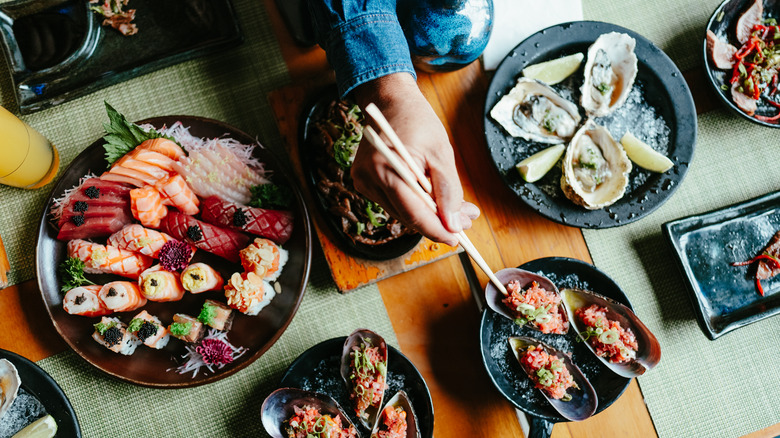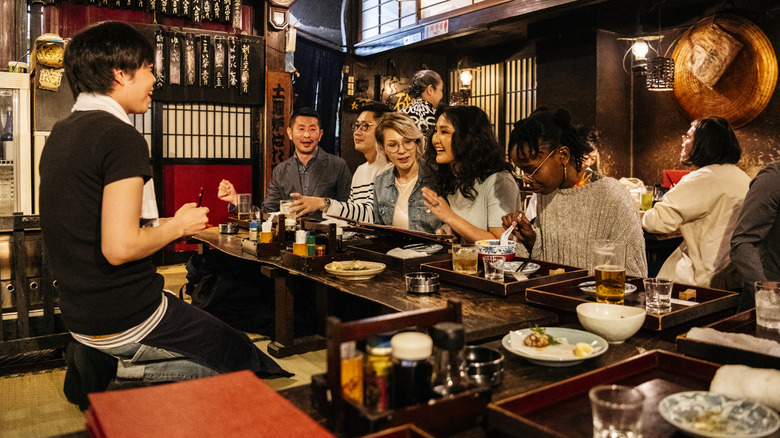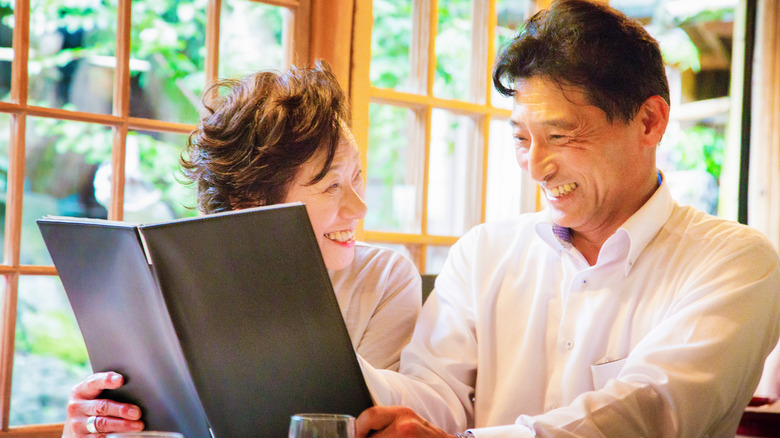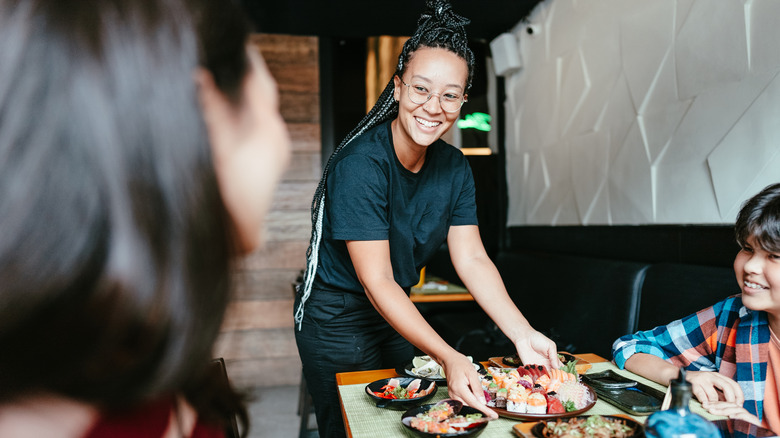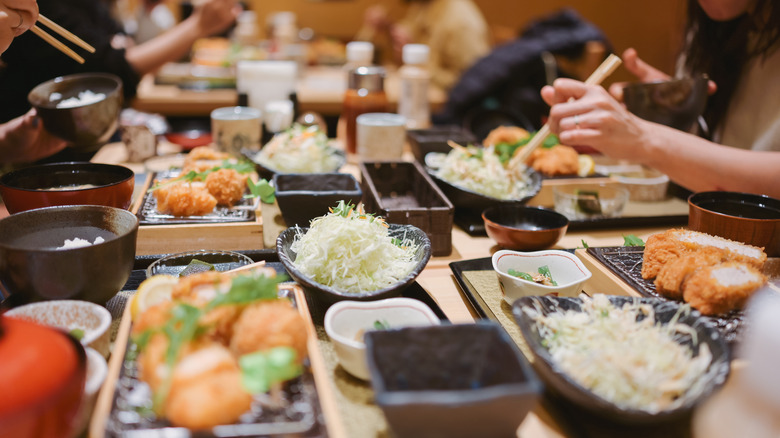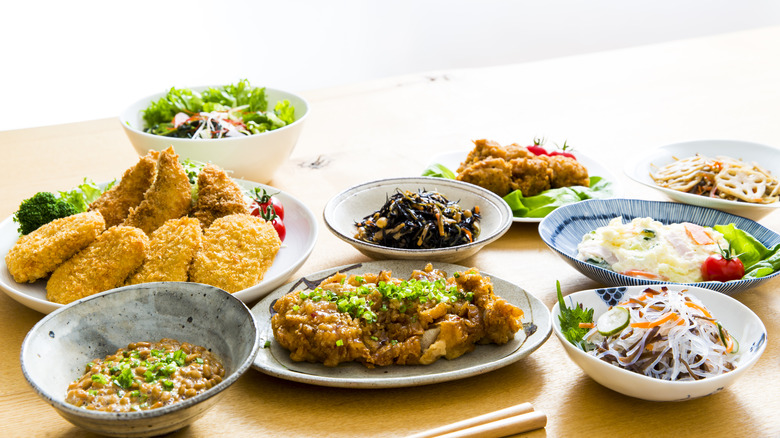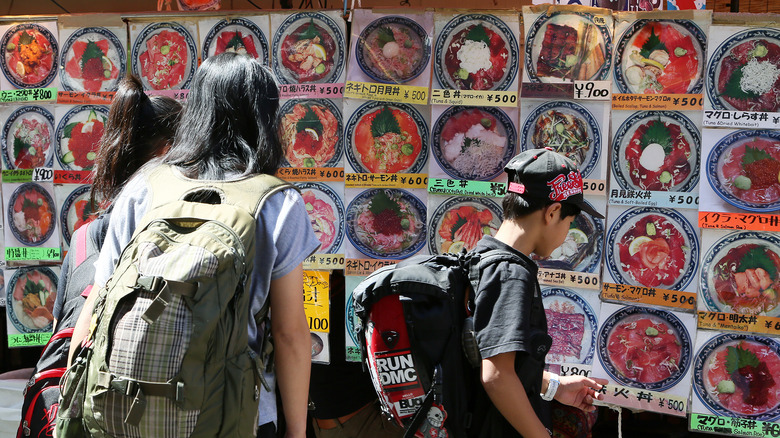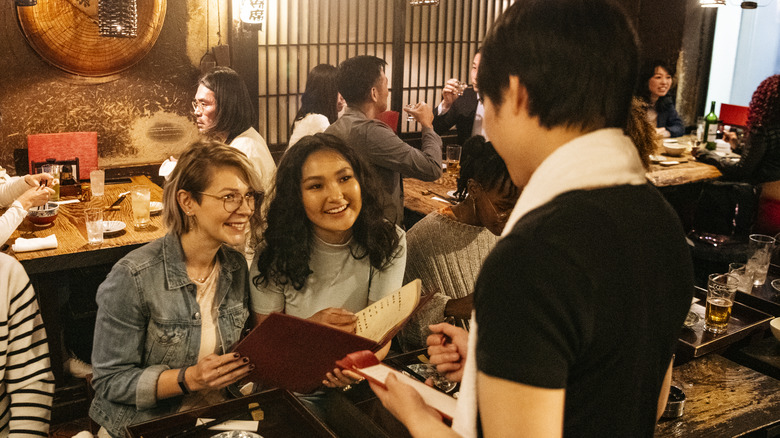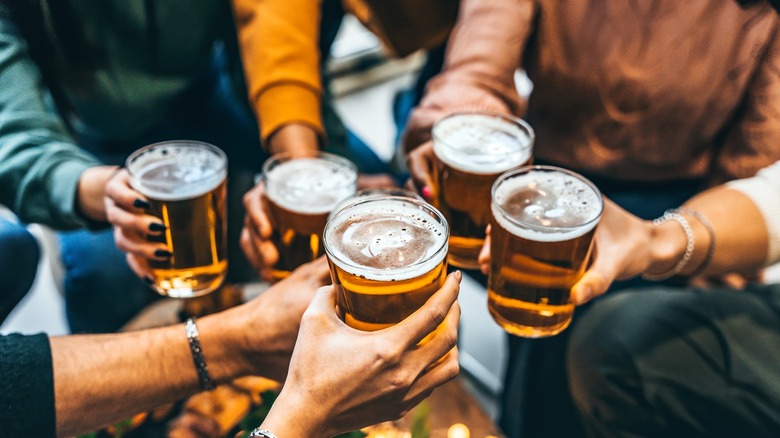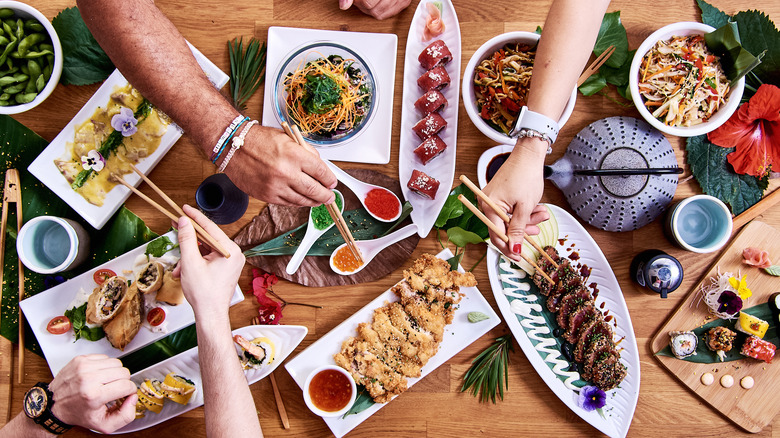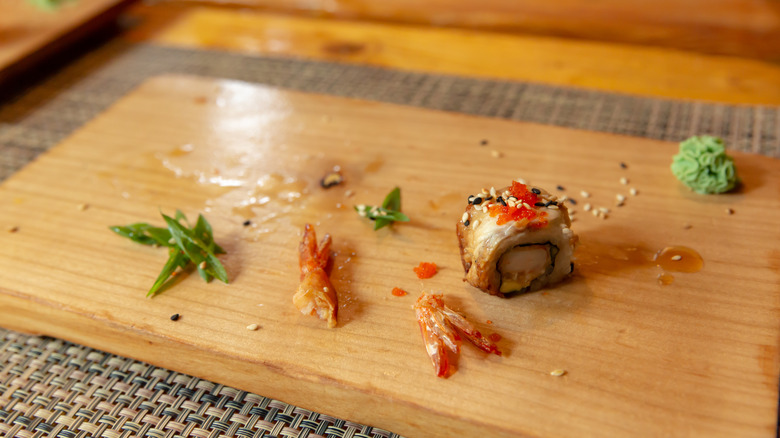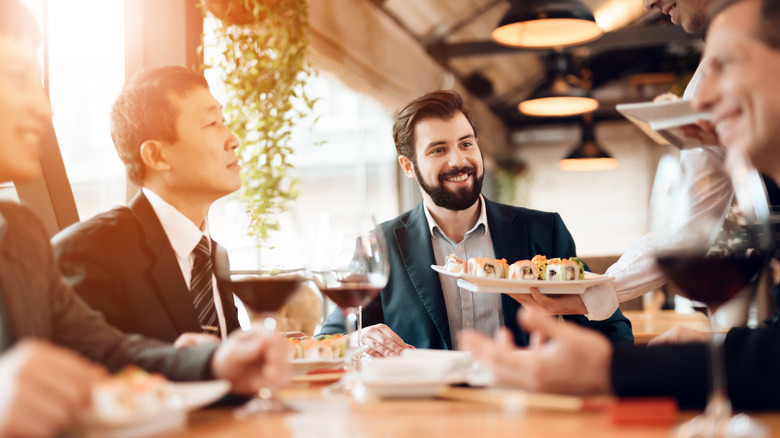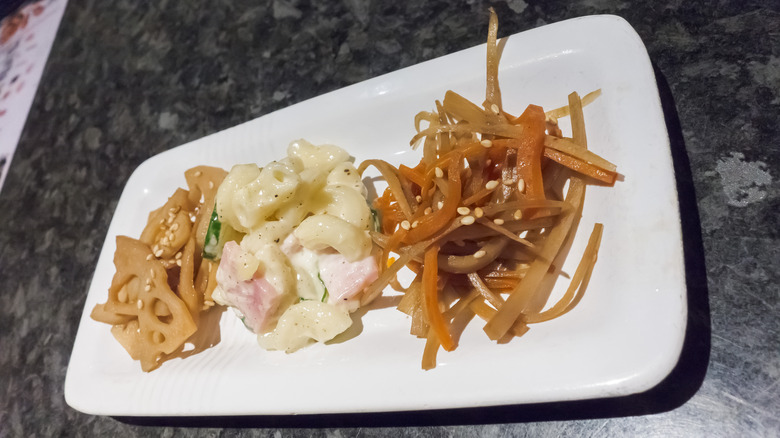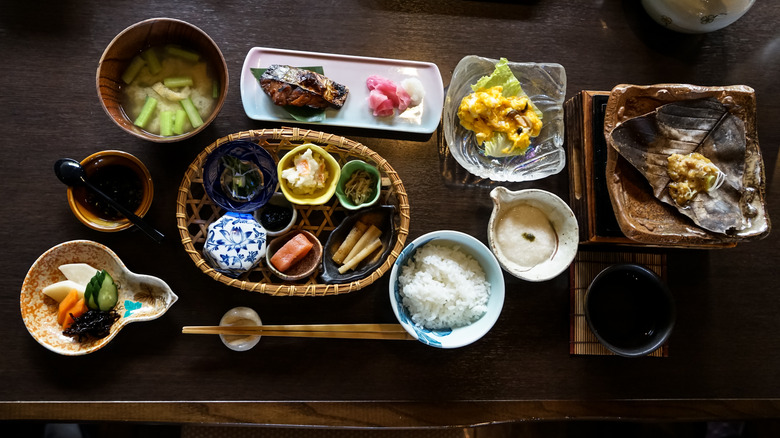Mistakes People Make When Ordering Food At A Japanese Restaurant
From steaming bowls of ramen to fresh plates of sushi and squidgy mochi for dessert, there's so much to enjoy at a Japanese restaurant. But whether you're visiting Japan or you're simply eating out at a Japanese spot in town, there are some common mistakes you can fall foul of. In Japan, some tourists don't realize the protocols for ordering food, some of the etiquette attached to how much you order, and whether or not you can finish all of your meal.
But there are mistakes you can make when ordering Japanese food in the U.S., too. For instance, you might miss out on ordering something great because you were afraid to ask for recommendations. Or you might end up with a dish you don't like because you didn't want to ask for the ingredients or tasted like.
While many of the mistakes on this list are more relevant when you're visiting Japan, they may also come into play in highly traditional Japanese restaurants in other parts of the world. This is especially true if it's a restaurant that mostly caters to Japanese diners. So, don't embarrass yourself or end up with a meal you don't like. Learn more about these mistakes people make when ordering food at a Japanese restaurant and how to avoid them.
Not realizing you have to call your waiter over to order
In the U.S., it's expected that a waiter will come over to take your order after giving you a bit of time to peruse the menu. Calling them over to order food would seem borderline rude. But things are different when ordering food in Japan. While a waiter might come over after some time, you can't count on it. Instead, it's up to you to call the waiter over when you're ready.
This is because restaurants in Japan are often quite busy. It takes time and headspace for waiters to remember who has and hasn't ordered and to keep an eye on tables to see when they appear like they're ready to order. So, what you should do instead is raise your hand, make eye contact with a waiter, and call out "sumimasen." This means "excuse me" in Japanese. In some particularly loud or busy restaurants, expect to call out a few times before a waiter comes over. This might seem uncomfortable from a U.S. perspective, but it's not at all considered rude in Japan. It's also worth noting that some newer and more high-tech restaurants have a call button you can press to attract your waiter's attention.
Not asking for more time to look at the menu if you need it
We've explained that you usually have to call your waiter over to order when you're in a restaurant in Japan. However, there are some exceptions. In certain restaurants, waiters may come to your table without being called, especially if it's a quiet time of day or the restaurant caters to a lot of tourists. And, of course, in Japanese restaurants in North America, it won't be common practice to call your waiter the way you would in Japan.
So, imagine a waiter has come to your table and you've not yet decided what you want to eat. Many people get flustered and end up ordering something on the fly, but there's no need to do so. It's perfectly fine to ask for more time to look at the menu before you order. If you're new to Japanese food, the unfamiliar dishes on the menu might take some deciphering, so it's perfectly normal to request another 5 or 10 minutes to peruse your menu.
Being impolite
Naturally, you know that you shouldn't be rude to your waiter. Or at least, we hope you do. However, when you're eating out in Japan, it's important to know a little about how to order food politely. Now, you shouldn't expect waiters to speak English in Japan, so you'll need to come armed with at least a little rudimentary Japanese.
It's quite simple to order food politely in Japanese. You just say the name of the food you want, followed by "kudasai," which means "please." So, you might say "tonkatsu, kudasai" or "inari, kudasai." If you don't know how to say the name of the dish you want, it's perfectly acceptable to point at the dish you want on the menu and say "kore, kudasai" — "this, please." When you're done ordering, you should say "ijou desu," which lets the waiter know that's everything that you want.
As we mentioned earlier, you should use "sumimasen" to call over your waiter to order. It also falls into the realm of politeness to use the same word to call your waiter the same way for anything else you might need, such as to make a change to your order or to ask for your bill when you're done.
Assuming all Japanese food is sushi
If you've walked into a Japanese restaurant expecting to see nothing but sushi on the menu, you're severely underestimating the diversity of Japanese food. Sushi is just one type of many traditional Japanese foods and is usually only found in sushi restaurants. This is especially true in Japan, while in the U.S. you may find some Japanese restaurants with both sushi and other Japanese dishes on the menu.
Other popular Japanese foods include (but certainly aren't limited to) ramen, soba, hotpots, donburi, tempura, tonkatsu, kare, and okonomiyaki. Just like you can go to a pizzeria or a burger bar in the U.S., in Japan, a lot of restaurants are dedicated to just one kind of food. So, you have ramen restaurants, udon and soba restaurants, kare restaurants that specialize in curry rice dishes, and tempura restaurants that specialize in tempura-related dishes, such as tempura donburi (or rice bowls). This is just a handful of the types of cuisine-specific restaurants you'll find in Japan.
Then, you have the more general restaurants. There are izakaya, which are drinking restaurants that serve a range of traditional small dishes alongside alcohol. You can also find shokudo, which are casual family restaurants that serve various Japanese foods, and kaiseki ryori, which serve Japanese haute cuisine. So, don't think that ordering from a Japanese restaurant means sushi will be on the menu.
Not asking for recommendations
New to Japanese food? Not sure what to order? If this sounds like you and you're not asking for recommendations from your waiter, then you're making a mistake. It's the obvious way to try a dish that's got the seal of approval from someone in the know. Even if you're well-versed in Japanese cuisine, you could end up with a new favorite that you wouldn't have thought to try if you'd been deciding for yourself.
If you're ordering in a Japanese restaurant in the U.S., asking for a recommendation is straightforward. But when you're in Japan, you'll need to know how to ask. You can ask your waiter "osusume wa nandesuka?" This means "What do you recommend?" If you ask for recommendations in this way, remember to thank your waiter to show proper appreciation for giving their opinions, since politeness is extremely important in Japanese culture.
While you don't have to order the dish that your waiter recommends if it isn't to your taste, you shouldn't ask for recommendations if you have no intention of trying a dish that's outside of your comfort zone. But if you're up for something new or you just don't know what to pick, asking for a recommendation is a great tactic.
Not asking for an English menu
Eating out in Japan can be a little disorientating for people who don't speak Japanese. Unlike some European countries, it's not a given that wait staff will be able to speak to you in English to explain the menu. While some restaurants in the most touristy areas of big cities will have English-speaking waiters, you certainly shouldn't head to Japan relying on it. However, rather than trying to decipher kanji or hiragana (Japanese characters), you can ask for an English menu.
To ask your waiter in Japanese if they have an English menu, say "eigo no menyuu wa arimasu ka?" However, note that, just because you can ask for an English menu, it doesn't mean that place you're eating at will definitely have one. Small family-run restaurants, especially those outside major tourist areas, might only have their menus written in Japanese and you'll have to make do. In some cases, you'll find pictures on the menu to help you out. There are also various apps available for phones that can translate text in photos.
Being afraid to ask about foods you don't know
When ordering at a Japanese restaurant, it's a mistake not to ask about food that you're unsure about. When you're new to a certain type of Japanese cuisine, there's always bound to be things you don't know — and you shouldn't be afraid to ask about them. So, if you see kakiage or shabu-shabu on the menu and you're not sure what they are, just ask and you'll find out. You can get clarification by asking what kinds of ingredients these foods contain or what they taste like.
Of course, assuming you don't speak fluent Japanese, this is going to be an easier task if you're ordering in English. When you're ordering in Japanese, it may be simpler to ask some yes/no questions about the dish. For instance, you could ask "kore wa karai?" (is this spicy?) or "kore wa suppai?" (is this sour?). With the right questions, you can learn more about a dish and figure out whether or not it's something you'll like.
Ordering drinks before food
In U.S. restaurants, it's quite normal to order drinks before food. This gives you some time to pour over the menu without having to wait too long for your drinks. However, in Japan, it's customary to order food and drinks at the same time. This saves time for waiters in busy restaurants. So, don't call your waiter over to order food until you've decided what you want to eat and what to drink.
Izakaya are the exception to this. These are considered drinking restaurants — a little bit like pubs or bars that serve food. At izakaya, it's normal to order a drink soon after you arrive, then sit and drink while you decide what you'd like to eat. However, this only applies to restaurants in Japan. If you visit a Japanese restaurant in the U.S., it's usual to order your drinks before you order your food, as you would do in most other eateries.
Only ordering one dish
While there are exceptions to this rule, it can be a mistake to only order one dish at a Japanese restaurant. If you only order one thing, you're only going to get the chance to try that one thing. Whereas, when you order several small dishes, you'll sample more delicious flavors.
This admittedly depends on the type of restaurant you're at, though. Izakaya, for instance, often specialize in small dishes — such as yakitori, gyoza, and katsu — to be shared among the table. At a ramen restaurant, on the other hand, you're more likely to order one large dish and keep it to yourself. That said, if you're eating with a group, you could also order a few sides to share between all of you so you can sample extra food. If you're not sure what the size of the plates are or how much is the right amount for you or your group, you can always ask. In many cases, you can order more dishes at a later point in your meal, should you decide you haven't ordered enough.
Ordering more food than you can eat
Portion sizes are often large in the U.S. and it's not uncommon to end up with more food on your plate than you can handle. This is expected and it isn't a problem. However, in Japan, it's considered poor etiquette to leave food on your plate. This relates to the concept of mottainai, which is a type of regret over having wasted something. So, you should always try not to order more food than you can manage when you're eating out in Japan. And you certainly shouldn't order dessert if you've left some of your main course on your plate.
Now, you might be thinking that you could solve this issue by asking for your food to be boxed up to go. You'll eat the leftovers tomorrow, nothing goes to waste, and everyone's happy. Well, this might sound good in theory, but doggy bags aren't really a thing in Japan. It's not just that restaurant staff are reluctant to send you home with your leftovers — in many cases, it's prohibited by law. There are strict food safety laws in Japan, and unless a restaurant has a special license to sell takeaway food, staff can't box up your food for you. This is due to the potential risks of someone taking food home, failing to store or reheat it properly, and then getting sick from the food.
Assuming all your food will arrive together
You ordered all your food at the same time, so why isn't it arriving together? This might be a reasonable question to ask at a standard American restaurant, but a Japanese kitchen doesn't really work that way. It's extremely common for dishes to arrive at different times, even if they were ordered together, so don't be surprised or think that the chefs or your waiter have forgotten about you.
The difference is due to the way food is generally cooked and served in Japanese restaurants. In a U.S. eatery, it's normal for dishes to sit under a heat lamp until the whole table's dishes are ready to serve. But in a Japanese restaurant, dishes are served the minute they're ready. This is so they can be enjoyed while they're fresh and at their best.
Consequently, if you order a dish that's quick to cook and your dining companion orders something more complicated, you might get yours 10 to 20 minutes before them. While it's considered rude in some cultures to start before everyone has their food, you should let go of that concept in a Japanese restaurant. Whoever gets their food first should just start eating. If you're worried about that, you could order sides that are likely to come out quickly, such as edamame.
Not knowing about otoshi when you order drinks
When you order an alcoholic drink in an izakaya — or drinking restaurant — you get small dishes called otoshi brought out with your beverages. If you aren't expecting to get these dishes when you order a drink, you might wonder what's up. Maybe you'd assume that the waiter made a mistake, or you accidentally ordered something you didn't mean to. But, no. This is just a normal part of eating in this kind of Japanese restaurant.
What's great about otoshi is that if you arrive at the izakaya incredibly hungry, it gives you something to snack on while you decide on food. These dishes are also great when, once you've ordered, your food ends up being the last to arrive. But what are otoshi exactly? Well, this can vary. They can be all manner of small, traditional dishes, pickled cucumber, salads, steamed meat or veggies, or grilled fish.
The last thing to know is that otoshi aren't free. Each one costs roughly $2.50 to $5, depending on the dish and the restaurant. You don't tip at restaurants in Japan, so in drinking restaurants where people might end up staying all night, ordering more drinks than food, these dishes act as a kind of socially acceptable service charge or table charge.
Expecting American portion sizes when you order
American portion sizes are known for being large. Portion sizes in Japan — as well as in some traditional Japanese restaurants in the U.S. — are significantly smaller. So, if you order expecting American-sized portions, you might end up going away hungry. This can be tough to navigate, as you won't know exactly how big a dish is until it comes out, but using some common sense, you can make an educated guess.
If you usually find an average main dish is about the right amount of food for you, then you might want to order a starter or side along with your main. If you usually happily get through three courses when you eat out, you might want to do that, plus get some sides for the table.
Japanese food generally comes out as it's cooked, so it's usually no problem to order something extra later in the meal — especially if it's something likely to come out of the kitchen quickly. So, if in doubt, start conservatively and order more if you need to. As we've already mentioned, it's poor form to leave food on your plate in Japan, so be aware of smaller portion sizes, but don't order more than you can eat.
